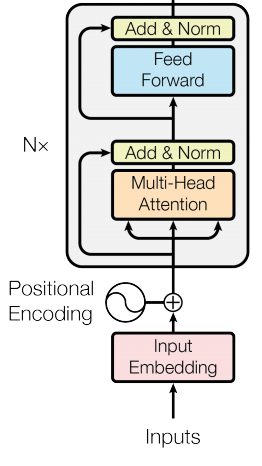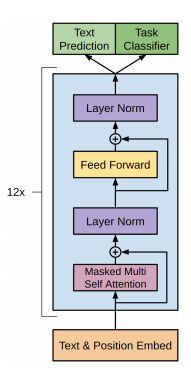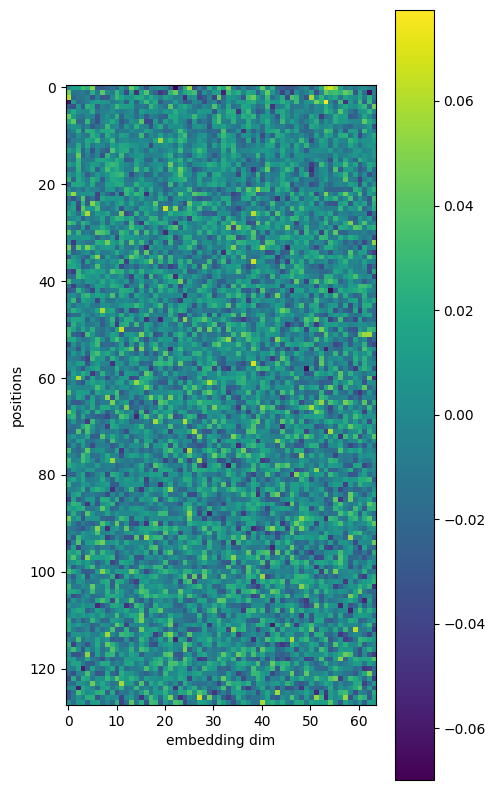Transformers for Language Modelling
Contents
4. Transformers for Language Modelling#
As we have familiarized ourselves with the attention mechanism in Transformers, now let’s see how these models can be trained as language models.
In the first part, I prepared a few pretrained language models for you to examine and play with.
In the second part, we will train a transformer language model from scratch.
We will handcraft a simple English language with Probabilistic Context free Grammar.
Then let the GPT learn this artificial language, and we will examine the emergent phenomena from training.
4.1. Play with Pre-trained transformers language models#
transformers library from huggingface is the de facto standard library for loading and using transformer architectures.
Let’s load some common models and see their inner architecture. Specifically, we will look at two classic models, BERT and GPT2. (developped ~ 2018)
They are both transformers but with some prominal differences
BERT: Bidirectional Encoder Representations from Transformers
Architecture: All-to-all attention. Transformer Encoder.
Objective: Masked language modelling
Usage:
Can fill in blanks and perform cloze task
Provide representation for many downstream language understanding tasks.
GPT2: Generative Pre-trained Transformer 2
Architecture: Causal attention. Transformer Decoder
Objective: autoregressive language modelling
Usage:
Can continue prompt and answer questions
Can be finetuned to follow task specific instructions.
Here are the conceptual picture of BERT and GPT2, let’s keep it in mind and try to map them to the modules we see
BERT

GPT2

4.1.1. Loading#
import transformers
from transformers import GPT2Tokenizer, GPT2Model, GPT2Config, GPT2LMHeadModel, DataCollatorForLanguageModeling
from transformers import pipeline, BertModel, BertConfig, BertTokenizer, BertLMHeadModel
import torch
import torch.nn as nn
def recursive_print(module, prefix="", depth=0, deepest=3):
"""Simulating print(module) for torch.nn.Modules
but with depth control. Print to the `deepest` level. `deepest=0` means no print
"""
if depth == 0:
print(f"[{type(module).__name__}]")
if depth >= deepest:
return
for name, child in module.named_children():
if len([*child.named_children()]) == 0:
print(f"{prefix}({name}): {child}")
else:
if isinstance(child, nn.ModuleList):
print(f"{prefix}({name}): {type(child).__name__} len={len(child)}")
else:
print(f"{prefix}({name}): {type(child).__name__}")
recursive_print(child, prefix + " ", depth + 1, deepest)
4.1.2. BERT#
# Accessing the model configuration
BERTtokenizer = BertTokenizer.from_pretrained('bert-base-uncased')
BERTmodel = BertModel.from_pretrained('bert-base-uncased')
BERTconfig = BERTmodel.config
BERTconfig
BertConfig {
"_name_or_path": "bert-base-uncased",
"architectures": [
"BertForMaskedLM"
],
"attention_probs_dropout_prob": 0.1,
"classifier_dropout": null,
"gradient_checkpointing": false,
"hidden_act": "gelu",
"hidden_dropout_prob": 0.1,
"hidden_size": 768,
"initializer_range": 0.02,
"intermediate_size": 3072,
"layer_norm_eps": 1e-12,
"max_position_embeddings": 512,
"model_type": "bert",
"num_attention_heads": 12,
"num_hidden_layers": 12,
"pad_token_id": 0,
"position_embedding_type": "absolute",
"transformers_version": "4.39.3",
"type_vocab_size": 2,
"use_cache": true,
"vocab_size": 30522
}
4.1.3. Let BERT do a cloze test#
unmasker = pipeline('fill-mask', model='bert-base-uncased')
unmasker("Hello I'm a [MASK] model.")
Some weights of the model checkpoint at bert-base-uncased were not used when initializing BertForMaskedLM: ['bert.pooler.dense.bias', 'bert.pooler.dense.weight', 'cls.seq_relationship.bias', 'cls.seq_relationship.weight']
- This IS expected if you are initializing BertForMaskedLM from the checkpoint of a model trained on another task or with another architecture (e.g. initializing a BertForSequenceClassification model from a BertForPreTraining model).
- This IS NOT expected if you are initializing BertForMaskedLM from the checkpoint of a model that you expect to be exactly identical (initializing a BertForSequenceClassification model from a BertForSequenceClassification model).
[{'score': 0.10731107741594315,
'token': 4827,
'token_str': 'fashion',
'sequence': "hello i'm a fashion model."},
{'score': 0.08774460107088089,
'token': 2535,
'token_str': 'role',
'sequence': "hello i'm a role model."},
{'score': 0.05338377505540848,
'token': 2047,
'token_str': 'new',
'sequence': "hello i'm a new model."},
{'score': 0.04667223244905472,
'token': 3565,
'token_str': 'super',
'sequence': "hello i'm a super model."},
{'score': 0.027095822617411613,
'token': 2986,
'token_str': 'fine',
'sequence': "hello i'm a fine model."}]
4.1.4. Inner structure of BERT#
recursive_print(BERTmodel,deepest=1)
[BertModel]
(embeddings): BertEmbeddings
(encoder): BertEncoder
(pooler): BertPooler
recursive_print(BERTmodel.encoder,deepest=2)
[BertEncoder]
(layer): ModuleList len=12
(0): BertLayer
(1): BertLayer
(2): BertLayer
(3): BertLayer
(4): BertLayer
(5): BertLayer
(6): BertLayer
(7): BertLayer
(8): BertLayer
(9): BertLayer
(10): BertLayer
(11): BertLayer
recursive_print(BERTmodel.encoder.layer[0],deepest=2)
[BertLayer]
(attention): BertAttention
(self): BertSelfAttention
(output): BertSelfOutput
(intermediate): BertIntermediate
(dense): Linear(in_features=768, out_features=3072, bias=True)
(intermediate_act_fn): GELUActivation()
(output): BertOutput
(dense): Linear(in_features=3072, out_features=768, bias=True)
(LayerNorm): LayerNorm((768,), eps=1e-12, elementwise_affine=True)
(dropout): Dropout(p=0.1, inplace=False)
recursive_print(BERTmodel.encoder.layer[0].attention,deepest=2)
[BertAttention]
(self): BertSelfAttention
(query): Linear(in_features=768, out_features=768, bias=True)
(key): Linear(in_features=768, out_features=768, bias=True)
(value): Linear(in_features=768, out_features=768, bias=True)
(dropout): Dropout(p=0.1, inplace=False)
(output): BertSelfOutput
(dense): Linear(in_features=768, out_features=768, bias=True)
(LayerNorm): LayerNorm((768,), eps=1e-12, elementwise_affine=True)
(dropout): Dropout(p=0.1, inplace=False)
4.1.5. GPT2#
GPTtokenizer = GPT2Tokenizer.from_pretrained('gpt2')
GPTmodel = GPT2Model.from_pretrained('gpt2')
GPTconfig = GPT2Config.from_pretrained('gpt2')
GPTconfig
GPT2Config {
"activation_function": "gelu_new",
"architectures": [
"GPT2LMHeadModel"
],
"attn_pdrop": 0.1,
"bos_token_id": 50256,
"embd_pdrop": 0.1,
"eos_token_id": 50256,
"initializer_range": 0.02,
"layer_norm_epsilon": 1e-05,
"model_type": "gpt2",
"n_ctx": 1024,
"n_embd": 768,
"n_head": 12,
"n_inner": null,
"n_layer": 12,
"n_positions": 1024,
"reorder_and_upcast_attn": false,
"resid_pdrop": 0.1,
"scale_attn_by_inverse_layer_idx": false,
"scale_attn_weights": true,
"summary_activation": null,
"summary_first_dropout": 0.1,
"summary_proj_to_labels": true,
"summary_type": "cls_index",
"summary_use_proj": true,
"task_specific_params": {
"text-generation": {
"do_sample": true,
"max_length": 50
}
},
"transformers_version": "4.39.3",
"use_cache": true,
"vocab_size": 50257
}
4.1.6. Let GPT say something#
GPTLMmodel = GPT2LMHeadModel.from_pretrained('gpt2')
input_ids = GPTtokenizer.encode("The meaning of life")
out_ids = GPTLMmodel.generate(torch.tensor(input_ids).long()[None,:],
max_length=32, do_sample=True, top_k=0, top_p=0.9, temperature=0.7,
num_return_sequences=5,)
for seq in out_ids:
print(GPTtokenizer.decode(seq))
The attention mask and the pad token id were not set. As a consequence, you may observe unexpected behavior. Please pass your input's `attention_mask` to obtain reliable results.
Setting `pad_token_id` to `eos_token_id`:50256 for open-end generation.
The meaning of life is a matter of faith, but it is also a matter of love. God is a good person, but not a good God. If
The meaning of life as we know it is an eternal struggle between the two. We are both members of the same family. We both live in a world where
The meaning of life in this world is so far removed from the human condition that it is hard to know what to make of it. The question is: How
The meaning of life is life-giving and life is life. That is why God gives us life. And this is why God gives us life.
The meaning of life is not simply the act of maintaining it, but the act of preserving it. It is the act of keeping it, of maintaining it,
4.1.7. Inner structure of GPTmodel#
recursive_print(GPTmodel,deepest=1)
[GPT2Model]
(wte): Embedding(50257, 768)
(wpe): Embedding(1024, 768)
(drop): Dropout(p=0.1, inplace=False)
(h): ModuleList len=12
(ln_f): LayerNorm((768,), eps=1e-05, elementwise_affine=True)
recursive_print(GPTmodel.h,deepest=1)
[ModuleList]
(0): GPT2Block
(1): GPT2Block
(2): GPT2Block
(3): GPT2Block
(4): GPT2Block
(5): GPT2Block
(6): GPT2Block
(7): GPT2Block
(8): GPT2Block
(9): GPT2Block
(10): GPT2Block
(11): GPT2Block
recursive_print(GPTmodel.h[0],deepest=1)
[GPT2Block]
(ln_1): LayerNorm((768,), eps=1e-05, elementwise_affine=True)
(attn): GPT2Attention
(ln_2): LayerNorm((768,), eps=1e-05, elementwise_affine=True)
(mlp): GPT2MLP
recursive_print(GPTmodel.h[0].attn,deepest=2)
[GPT2Attention]
(c_attn): Conv1D()
(c_proj): Conv1D()
(attn_dropout): Dropout(p=0.1, inplace=False)
(resid_dropout): Dropout(p=0.1, inplace=False)
recursive_print(GPTmodel.h[0].mlp,deepest=2)
[GPT2MLP]
(c_fc): Conv1D()
(c_proj): Conv1D()
(act): NewGELUActivation()
(dropout): Dropout(p=0.1, inplace=False)
4.2. Train a transformer to “speak your own language”!#
So let’s design an artificial language with simple grammar and let the transformer learn to “speak” it. More technically, this means, we hand-craft a probabilistic model of language (sequence) and then let the transformer learn it.
4.2.1. Probabilistic Generative Grammar#
First let’s make our simplified English grammar.
By building a set of probabilistic generative grammar, or more technically, Probabilistic context-free grammar, (PCFG)
This language has these part of speeches
Noun
Intransitive verb
Transitive verb
Article
Adjective
Conjunction “that”
##%% list of words and their parts of speech
# nouns
noun_list = ["cat", "dog", "fox", "bird", "horse", "sheep", "cow", "bear", "zebra", "giraffe"]
# intransitive verb
intrans_verb_list = ["ran", "jumped", "swam", "flew", "walked", "slept", "sat", "stood", "danced"]
# transitive verbs that took an object or a clause
trans_verbs_list = ["saw", "heard", "smelled", ]
# adjectives
adj_list = ["big", "small", "tall", "short", "long", "wide", "fat", "thin", "round", "square", "smart", "pretty"]
# adverbs
article_list = ["the", "a"]
# conjunctive that introduces a clause.
conjunction_list = ["that"]
This language also has the following grammar, i.e. a set of substitution rules. For example,
means a sentence can be substituted by a Noun phrase (NP) + a Verb phrase (VP). $\(VP\to TV, Conj, NP, VP\)$ means a verb phrase can be substituted by a transitive verb (TV) + a conjunction (Conj) + a Noun phrase (NP) + a Verb phrase (VP).
The full set of rules are following, feel free to modify it!
# Rules for mapping part of speech to words
word_map = {
"N": noun_list,
"IV": intrans_verb_list,
"TV": trans_verbs_list,
"Adj": adj_list,
"Article": article_list,
"Conj": conjunction_list,
}
# Grammar for generating sentences
rules = {
# sentence
"S": [["NP", "VP"]],
# noun phrase
"NP": [["Article", "N"],
["Article", "Adj", "N"],
["Article", "Adj", "Adj", "N"],
["Article", "N", "Conj", "IV"]],
# verb phrase
"VP": [["IV"],
["TV", "NP"],
["TV", "Conj", "NP", "VP"], ],
}
4.2.2. Sample from probabilistic generative grammar#
Now, see what these rules can generate using probabilistic generative grammar, i.e. recursively applying the substitution rules to an initial token \(S\) to elaborate it.
import random
def generate_sentences(rules, word_map, max_depth=3, show=False):
""" A sentence generator with probabilistic generative grammar. """
initial_token = "S"
sentence = [initial_token]
depth = 0
while True:
next_sentence = []
fully_expanded = True
for token in sentence:
if token in rules:
# expand the phrase
if depth < max_depth:
next_sentence.extend(random.choice(rules[token]))
else:
# to limit complexity, we stop adding clauses
next_sentence.extend(random.choice(rules[token][:-1])) # don't expand into the last conjunctive rule
fully_expanded = False
else:
next_sentence.append(token)
sentence = next_sentence
depth += 1
if show:
print(sentence)
if fully_expanded:
break
# turn tokens into words
verbal_sentence = []
for token in sentence:
word = random.choice(word_map[token])
verbal_sentence.append(word)
sent_str = " ".join(verbal_sentence)
return verbal_sentence, sent_str
word_seq, sentence_str = generate_sentences(rules, word_map, show=True, max_depth=5)
print(sentence_str)
['NP', 'VP']
['Article', 'N', 'Conj', 'IV', 'TV', 'Conj', 'NP', 'VP']
['Article', 'N', 'Conj', 'IV', 'TV', 'Conj', 'Article', 'N', 'TV', 'NP']
['Article', 'N', 'Conj', 'IV', 'TV', 'Conj', 'Article', 'N', 'TV', 'Article', 'N', 'Conj', 'IV']
['Article', 'N', 'Conj', 'IV', 'TV', 'Conj', 'Article', 'N', 'TV', 'Article', 'N', 'Conj', 'IV']
a cat that slept smelled that the zebra smelled the giraffe that ran
Surely you can generate all kinds of nonsensical sentences which are grammatically correct!
a small big cow smelled the thin fat zebra
But let’s ignore it for a moment and let a transformer learn to “speak” this simply English.
4.2.3. Tokenization: map words to numbers#
For a computational system to understand language, first, we need to break the sentence into words and turn the words into something they know , indices. This is known as tokenization and encoding.
full_word_set = set(sum([words for words in word_map.values()], []))
dictionary = {word: i for i, word in enumerate(full_word_set)} # Mapping words to indices
dictionary["[End]"] = len(dictionary)
EOS_ID = dictionary["[End]"] # end of sentence token
PAD_ID = len(dictionary) # padding token
dictionary[""] = PAD_ID
inverse_dictionary = {i: word for word, i in dictionary.items()} # Mapping indices to words
def tokenize_sentence(sentence):
""" Tokenize a sentence into a list of words. """
word_seq = sentence.split(" ")
return word_seq
def encode_sentence(sentence):
""" Encode a sentence into a list of indices. """
word_seq = tokenize_sentence(sentence)
inds = encode2indices(word_seq)
return inds
def encode2indices(word_seq):
""" Encode a list of words into a list of indices. """
inds = [dictionary[word] for word in word_seq]
return inds
def decode2words(indices):
""" Decode a list of indices into a list of words. """
words = [inverse_dictionary[ind] for ind in indices]
return words
def decode2sentence(indices):
""" Decode a list of indices into a sentence. """
words = decode2words(indices)
sentence = " ".join(words)
return sentence
encode_sentence("a smart fox saw a cat that ran")
[2, 3, 1, 26, 2, 10, 30, 19]
4.2.4. Build Sequence Dataset: pad_seq etc.#
Since we don’t have a fixed dataset, but a generative model of language, we can simply generate new sentences on the fly and fed it to our transformer. (this is usually not the case)
import torch
from torch.nn.utils.rnn import pad_sequence
def batch_sampler(batch_size=32, max_len=128):
batch = []
for i in range(batch_size):
word_seq, _ = generate_sentences(rules, word_map)
word_seq.append("[End]") # add this marker to say, the sentence has ended.
inds = encode2indices(word_seq)
batch.append(torch.tensor(inds, dtype=torch.long))
# pad the batch to be equal length, same len as the longest senetence.
padded_batch = pad_sequence(batch, batch_first=True, padding_value=PAD_ID)
# chuck to the max_len
padded_batch = padded_batch[:, :max_len]
return padded_batch
batch = batch_sampler()
print(batch.shape)
for j in range(batch.shape[0]):
print(decode2sentence(batch[j].tolist()))
torch.Size([32, 20])
the cat that sat heard that the cat that sat smelled that the bird saw a sheep [End]
a dog swam [End]
a bird that swam heard that a giraffe smelled a fat horse [End]
a short smart dog saw that the sheep that stood saw that a bear sat [End]
the round cat swam [End]
the thin cow smelled a zebra that slept [End]
a bird heard that a cow saw a smart thin zebra [End]
a dog jumped [End]
a horse smelled that a cat danced [End]
the small dog saw that a wide bear smelled that the long sheep slept [End]
a thin thin cat slept [End]
a thin zebra saw the wide zebra [End]
the dog saw a big pretty cat [End]
the dog sat [End]
the small smart bear danced [End]
the horse that flew sat [End]
the sheep that stood smelled the sheep that jumped [End]
a long wide bird saw a zebra [End]
a zebra smelled that a big sheep walked [End]
a tall round fox saw the zebra [End]
a thin long bear walked [End]
the fox slept [End]
the fat short cat sat [End]
the big wide cat stood [End]
a long cow smelled that the horse that slept smelled the tall fat cat [End]
the long smart sheep smelled that a small cow heard the fat pretty bear [End]
the cat jumped [End]
a bird saw the zebra [End]
the wide small zebra jumped [End]
a fox smelled that the fat sheep smelled that the square fat fox walked [End]
the giraffe that walked saw that a dog that sat smelled that the wide tall giraffe smelled a cow [End]
the horse smelled that a bear saw a square smart horse [End]
4.2.5. Train a transformer on this language#
import torch
from torch.optim import AdamW
from transformers import GPT2Model, GPT2Tokenizer, GPT2LMHeadModel, GPT2Config
miniGPTconfig = GPT2Config(vocab_size=len(dictionary), n_positions=128, n_ctx=128,
n_embd=64, n_layer=3, n_head=8,
eos_token_id=EOS_ID, pad_token_id=PAD_ID)
miniGPT = GPT2LMHeadModel(miniGPTconfig, )
Finally, let’s run our training loops!
device = torch.device("cuda" if torch.cuda.is_available() else "cpu")
loss_curve = []
optimizer = AdamW(miniGPT.parameters(), lr=5e-4)
miniGPT.train()
miniGPT.to(device)
batch_size = 512
for epoch in range(3):
for i in range(50):
batch = batch_sampler(batch_size=batch_size)
output = miniGPT(batch.to(device), labels=batch.to(device), )
loss = output.loss
loss.backward()
optimizer.step()
optimizer.zero_grad()
print(f"epoch {epoch}, batch {i}, loss {loss.item()}")
loss_curve.append(loss.item())
miniGPT.eval().to("cpu")
We strongly recommend passing in an `attention_mask` since your input_ids may be padded. See https://huggingface.co/docs/transformers/troubleshooting#incorrect-output-when-padding-tokens-arent-masked.
epoch 0, batch 0, loss 3.2727038860321045
epoch 0, batch 1, loss 3.013523817062378
epoch 0, batch 2, loss 2.9508156776428223
epoch 0, batch 3, loss 2.864698648452759
epoch 0, batch 4, loss 2.8440003395080566
epoch 0, batch 5, loss 2.792489528656006
epoch 0, batch 6, loss 2.7530574798583984
epoch 0, batch 7, loss 2.712508201599121
epoch 0, batch 8, loss 2.7014684677124023
epoch 0, batch 9, loss 2.6464850902557373
epoch 0, batch 10, loss 2.6130788326263428
epoch 0, batch 11, loss 2.6004862785339355
epoch 0, batch 12, loss 2.5547451972961426
epoch 0, batch 13, loss 2.492750883102417
epoch 0, batch 14, loss 2.4694128036499023
epoch 0, batch 15, loss 2.4235713481903076
epoch 0, batch 16, loss 2.3857686519622803
epoch 0, batch 17, loss 2.4006121158599854
epoch 0, batch 18, loss 2.3581535816192627
epoch 0, batch 19, loss 2.2853527069091797
epoch 0, batch 20, loss 2.2719969749450684
epoch 0, batch 21, loss 2.2839810848236084
epoch 0, batch 22, loss 2.259561061859131
epoch 0, batch 23, loss 2.1954007148742676
epoch 0, batch 24, loss 2.1371004581451416
epoch 0, batch 25, loss 2.0955264568328857
epoch 0, batch 26, loss 2.1326050758361816
epoch 0, batch 27, loss 2.0571255683898926
epoch 0, batch 28, loss 2.0366766452789307
epoch 0, batch 29, loss 2.017181396484375
epoch 0, batch 30, loss 1.9762787818908691
epoch 0, batch 31, loss 1.9193634986877441
epoch 0, batch 32, loss 1.9848976135253906
epoch 0, batch 33, loss 1.9038301706314087
epoch 0, batch 34, loss 1.872957468032837
epoch 0, batch 35, loss 1.8023127317428589
epoch 0, batch 36, loss 1.8214008808135986
epoch 0, batch 37, loss 1.7515637874603271
epoch 0, batch 38, loss 1.7599962949752808
epoch 0, batch 39, loss 1.7228972911834717
epoch 0, batch 40, loss 1.7311118841171265
epoch 0, batch 41, loss 1.6666715145111084
epoch 0, batch 42, loss 1.6528854370117188
epoch 0, batch 43, loss 1.6836789846420288
epoch 0, batch 44, loss 1.6230767965316772
epoch 0, batch 45, loss 1.6041755676269531
epoch 0, batch 46, loss 1.55047607421875
epoch 0, batch 47, loss 1.5431965589523315
epoch 0, batch 48, loss 1.512395977973938
epoch 0, batch 49, loss 1.4878454208374023
epoch 1, batch 0, loss 1.484283685684204
epoch 1, batch 1, loss 1.5147674083709717
epoch 1, batch 2, loss 1.4420981407165527
epoch 1, batch 3, loss 1.4802629947662354
epoch 1, batch 4, loss 1.4735491275787354
epoch 1, batch 5, loss 1.3835302591323853
epoch 1, batch 6, loss 1.4120527505874634
epoch 1, batch 7, loss 1.3814001083374023
epoch 1, batch 8, loss 1.420322299003601
epoch 1, batch 9, loss 1.3910599946975708
epoch 1, batch 10, loss 1.3818882703781128
epoch 1, batch 11, loss 1.2963616847991943
epoch 1, batch 12, loss 1.2820688486099243
epoch 1, batch 13, loss 1.3216276168823242
epoch 1, batch 14, loss 1.3533740043640137
epoch 1, batch 15, loss 1.3162024021148682
epoch 1, batch 16, loss 1.334485650062561
epoch 1, batch 17, loss 1.2350927591323853
epoch 1, batch 18, loss 1.2650562524795532
epoch 1, batch 19, loss 1.1813908815383911
epoch 1, batch 20, loss 1.2223633527755737
epoch 1, batch 21, loss 1.2036733627319336
epoch 1, batch 22, loss 1.2159011363983154
epoch 1, batch 23, loss 1.1888813972473145
epoch 1, batch 24, loss 1.1954584121704102
epoch 1, batch 25, loss 1.202561616897583
epoch 1, batch 26, loss 1.1740601062774658
epoch 1, batch 27, loss 1.1533219814300537
epoch 1, batch 28, loss 1.1416406631469727
epoch 1, batch 29, loss 1.1652735471725464
epoch 1, batch 30, loss 1.1516095399856567
epoch 1, batch 31, loss 1.1084500551223755
epoch 1, batch 32, loss 1.1114088296890259
epoch 1, batch 33, loss 1.2187308073043823
epoch 1, batch 34, loss 1.1055666208267212
epoch 1, batch 35, loss 1.131159782409668
epoch 1, batch 36, loss 1.1152591705322266
epoch 1, batch 37, loss 1.1260128021240234
epoch 1, batch 38, loss 1.0647740364074707
epoch 1, batch 39, loss 1.110844373703003
epoch 1, batch 40, loss 1.0777372121810913
epoch 1, batch 41, loss 1.116552710533142
epoch 1, batch 42, loss 1.081486701965332
epoch 1, batch 43, loss 1.0923397541046143
epoch 1, batch 44, loss 1.1311514377593994
epoch 1, batch 45, loss 1.0535675287246704
epoch 1, batch 46, loss 1.033979892730713
epoch 1, batch 47, loss 1.0270079374313354
epoch 1, batch 48, loss 1.0034534931182861
epoch 1, batch 49, loss 1.1141964197158813
epoch 2, batch 0, loss 1.0811495780944824
epoch 2, batch 1, loss 1.0718233585357666
epoch 2, batch 2, loss 1.0568015575408936
epoch 2, batch 3, loss 1.054729700088501
epoch 2, batch 4, loss 1.0524795055389404
epoch 2, batch 5, loss 1.028294563293457
epoch 2, batch 6, loss 1.0320098400115967
epoch 2, batch 7, loss 1.0048317909240723
epoch 2, batch 8, loss 0.9804179072380066
epoch 2, batch 9, loss 0.9944889545440674
epoch 2, batch 10, loss 0.9846476316452026
epoch 2, batch 11, loss 1.0662739276885986
epoch 2, batch 12, loss 0.9852057695388794
epoch 2, batch 13, loss 0.9804151654243469
epoch 2, batch 14, loss 0.9822817444801331
epoch 2, batch 15, loss 0.9655719995498657
epoch 2, batch 16, loss 0.9616129994392395
epoch 2, batch 17, loss 0.9799185395240784
epoch 2, batch 18, loss 0.9711923003196716
epoch 2, batch 19, loss 0.9525609016418457
epoch 2, batch 20, loss 0.9145498871803284
epoch 2, batch 21, loss 0.9677637219429016
epoch 2, batch 22, loss 0.9333570599555969
epoch 2, batch 23, loss 0.9609147310256958
epoch 2, batch 24, loss 0.9711549878120422
epoch 2, batch 25, loss 0.949081301689148
epoch 2, batch 26, loss 0.9375740885734558
epoch 2, batch 27, loss 0.9734074473381042
epoch 2, batch 28, loss 0.9486612677574158
epoch 2, batch 29, loss 0.9926449060440063
epoch 2, batch 30, loss 0.9132639765739441
epoch 2, batch 31, loss 0.9556533098220825
epoch 2, batch 32, loss 0.9298215508460999
epoch 2, batch 33, loss 0.9498323202133179
epoch 2, batch 34, loss 0.950808048248291
epoch 2, batch 35, loss 0.922825038433075
epoch 2, batch 36, loss 0.893294632434845
epoch 2, batch 37, loss 0.948309600353241
epoch 2, batch 38, loss 0.8933826684951782
epoch 2, batch 39, loss 0.914124608039856
epoch 2, batch 40, loss 0.8858266472816467
epoch 2, batch 41, loss 0.9069903492927551
epoch 2, batch 42, loss 0.8635560274124146
epoch 2, batch 43, loss 0.9506620168685913
epoch 2, batch 44, loss 0.9094947576522827
epoch 2, batch 45, loss 0.9231759309768677
epoch 2, batch 46, loss 0.9350917935371399
epoch 2, batch 47, loss 0.9076787233352661
epoch 2, batch 48, loss 0.869784951210022
epoch 2, batch 49, loss 0.8812459111213684
GPT2LMHeadModel(
(transformer): GPT2Model(
(wte): Embedding(39, 64)
(wpe): Embedding(128, 64)
(drop): Dropout(p=0.1, inplace=False)
(h): ModuleList(
(0-2): 3 x GPT2Block(
(ln_1): LayerNorm((64,), eps=1e-05, elementwise_affine=True)
(attn): GPT2Attention(
(c_attn): Conv1D()
(c_proj): Conv1D()
(attn_dropout): Dropout(p=0.1, inplace=False)
(resid_dropout): Dropout(p=0.1, inplace=False)
)
(ln_2): LayerNorm((64,), eps=1e-05, elementwise_affine=True)
(mlp): GPT2MLP(
(c_fc): Conv1D()
(c_proj): Conv1D()
(act): NewGELUActivation()
(dropout): Dropout(p=0.1, inplace=False)
)
)
)
(ln_f): LayerNorm((64,), eps=1e-05, elementwise_affine=True)
)
(lm_head): Linear(in_features=64, out_features=39, bias=False)
)
4.2.6. Say Something? (or I’m Giving Up On You)#
prompt = "the dog"
prompt_inds = encode_sentence(prompt)
ind_tsr = miniGPT.generate(torch.tensor(prompt_inds).long()[None, :],
max_length=32, do_sample=True, top_k=0, top_p=0.9, temperature=0.7,
num_return_sequences=5, pad_token_id=PAD_ID)
for ind_seq in ind_tsr:
print(decode2sentence(ind_seq.tolist()))
the dog that heard that a bird that the square fox flew [End]
the dog saw a zebra [End]
the dog that slept flew [End]
the dog that walked saw that the sheep that danced saw that the smart smart giraffe swam [End]
the dog that sat saw that a fat fat sheep smelled that the thin square cow swam [End]
4.2.7. Does our transformer “understand” part-of-speech?#
import numpy as np
import matplotlib.pyplot as plt
from sklearn.cluster import KMeans
from sklearn.manifold import TSNE
First, let’s extract the embeddings of the words and the positions
token_embedding = miniGPT.transformer.wte.weight.detach()
position_embedding = miniGPT.transformer.wpe.weight.detach()
print(token_embedding.shape)
print(position_embedding.shape)
torch.Size([39, 64])
torch.Size([128, 64])
We’d want to see how these learned embeddings cluster.
tsne = TSNE(n_components=2, random_state=0, perplexity=15.0)
token_embedding_2d = tsne.fit_transform(token_embedding.numpy())
kmeans = KMeans(n_clusters=6, random_state=0).fit(token_embedding_2d)
d:\app\anaconda3\envs\open-machine-learning-jupyter-book\lib\site-packages\sklearn\cluster\_kmeans.py:870: FutureWarning: The default value of `n_init` will change from 10 to 'auto' in 1.4. Set the value of `n_init` explicitly to suppress the warning
warnings.warn(
plt.figure(figsize=[10, 10])
plt.scatter(token_embedding_2d[:, 0], token_embedding_2d[:, 1], c=kmeans.labels_)
# annotate each word on the plot
for i, word in enumerate(inverse_dictionary.values()):
plt.annotate(word, (token_embedding_2d[i, 0], token_embedding_2d[i, 1]), fontsize=12)
plt.show()

Let’s print out which words are in each cluster.
nCluster = 7
kmeans2 = KMeans(n_clusters=nCluster, random_state=42).fit(token_embedding.numpy())
# print the list of words in each cluster
for icluster in range(nCluster):
cluster_words = [word for word, ind in dictionary.items() if kmeans2.labels_[ind] == icluster]
print(f"cluster {icluster}: {cluster_words}")
cluster 0: ['smelled', 'saw', 'heard']
cluster 1: ['wide', 'fox', 'smart', 'small', 'tall', 'bird', 'short', 'cat', 'sheep', 'bear', 'cow', 'horse', 'giraffe', 'round', 'dog', 'big', 'zebra', 'square', 'thin', 'fat', 'pretty', 'long']
cluster 2: ['jumped', 'danced', 'walked', 'ran', 'stood', 'sat', 'swam', 'flew', 'slept']
cluster 3: ['[End]']
cluster 4: ['a', 'the']
cluster 5: ['']
cluster 6: ['that']
d:\app\anaconda3\envs\open-machine-learning-jupyter-book\lib\site-packages\sklearn\cluster\_kmeans.py:870: FutureWarning: The default value of `n_init` will change from 10 to 'auto' in 1.4. Set the value of `n_init` explicitly to suppress the warning
warnings.warn(
Overall birds eye view of the word representations (embeddings)
plt.figure(figsize=[10,5])
plt.imshow(token_embedding)
plt.ylabel("words")
plt.xlabel("embedding dim")
plt.colorbar()
plt.show()

plt.figure(figsize=[5,10])
plt.imshow(position_embedding)
plt.ylabel("positions")
plt.xlabel("embedding dim")
plt.colorbar()
plt.show()

4.3. Your turn! 🚀#
tbd.
4.4. Acknowledgments#
Thanks to Binxu Wang for creating the open-source course From Transformer to LLM: Architecture, Training and Usage. It inspires the majority of the content in this chapter.


